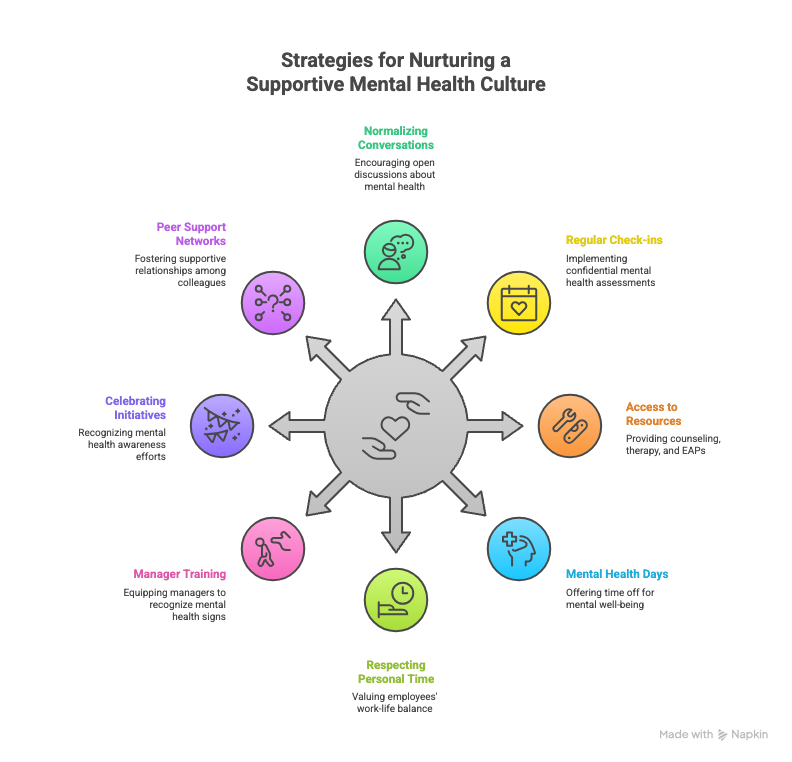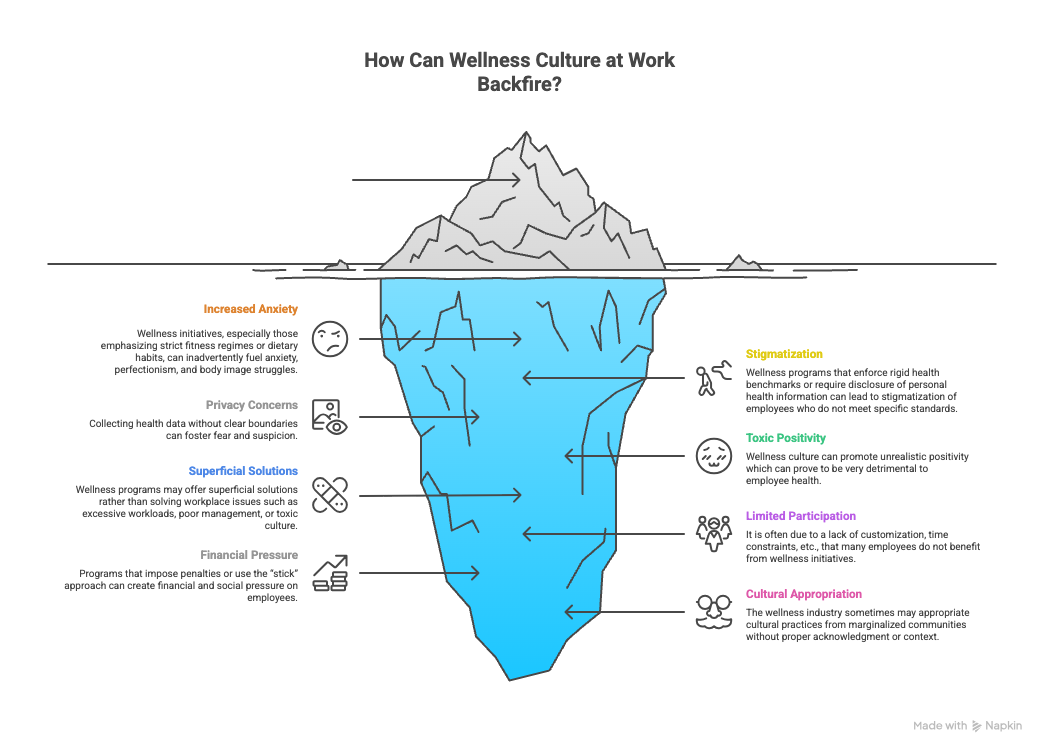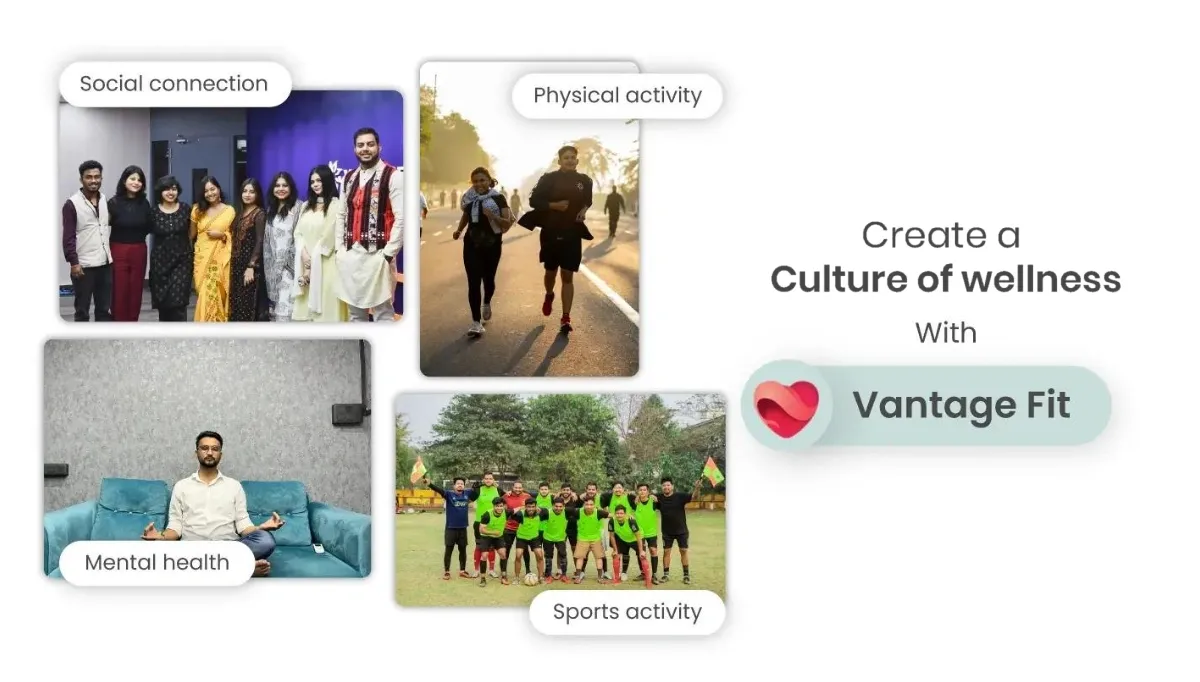Creating and Nurturing a Culture of Wellness in the Workplace that Actually Sticks
Workplaces have become the front lines in the battle for better employee health. With full-time employees spending nearly 47 hours each week on the job, the habits they form at work shape everything from stress levels to long-term disease risk.
New CDC data reveals that 40.3% of American adults now live with obesity, creating a workplace health crisis that cost U.S. businesses $425.5 billion in 2023. With 46.9 million employees affected, companies face $160.3 billion in lost productivity and $82.3 billion in missed workdays annually.
Against this backdrop, nearly half of American companies now offer some form of employee wellness program to boost wellbeing. However, many of these initiatives fail to take hold.
In this blog, we’ll explore how to transform isolated perks into a lasting, vibrant culture of wellness—one that embeds healthy habits into daily routines and delivers real, sustainable results.
Now, let us first understand -
What Does a Culture of Wellness Really Mean?

A culture of wellness is the conscious creation of an environment where human flourishing becomes the natural by-product of how business is conducted. It transcends the transactional relationship between employer and employee, evolving into something far more profound: a covenant of mutual care, growth, and shared purpose.
Such a culture operates from the understanding that wellness cannot be compartmentalized. It recognizes that the stress from an impossible deadline affects not only work performance but also sleep quality, family relationships, and long-term health.
To address these complex, interconnected challenges, the most sophisticated organizations employ behavioural economists to design choice architectures that make healthy decisions inevitable rather than effortful.
For instance, instead of exhorting employees to exercise more, these companies redesign physical spaces, host walking meetings, etc., to incorporate movement, social interaction, and cognitive recovery naturally.
This approach recognizes a simple truth: people can’t thrive in environments stacked against them. A culture of wellness flips that script, building workplaces that support good choices every day.
Why is a Culture of Health and Wellness Important?
The fundamental truth about wellness culture lies in a simple paradox: we all know what we need to do to achieve optimal health, yet few of us consistently do it.
This disconnect reveals the core problem with traditional workplace wellness approaches—simply introducing programs doesn't work because health must be embedded into the organizational ecosystem itself.
Dr. Oluwafemi Emmanuel of Anglia Ruskin University states,
strong cultures help organizations operate like ‘well-oiled’ machines, engaging in outstanding execution with only minor adjustments to existing procedures as needed.
Let us now understand the reasons describing why a culture of health and wellness is so vital:
Enhanced Productivity
When employees feel genuinely valued, their productivity naturally soars.
The American Psychological Association found that 93% of employees who felt valued reported being motivated to do their best work, compared to just 33% of those who didn't feel valued.
Microsoft's comprehensive wellness approach demonstrates this beautifully. Their $1,200 annual wellness stipend and 20 free counseling sessions per employee demonstrate a profound understanding that productivity thrives when people feel supported.
Increased Contentment
A company with a good culture will always have people who feel fulfilled from the inside. If a company looks after its employees’ health, has inclusive, well-intentioned health policies, and empathetic leaders, happiness/contentment are by-products.
Moreover, when workplaces support their employees, the brain releases serotonin, which boosts mood and job satisfaction. According to the Achievers Workforce Institute's 2024 research, employees who receive meaningful recognition at least monthly are 2.5 times more likely to feel a strong sense of belonging at work.
Better Lifestyle
Movement is key to mental clarity. Exercise releases ‘feel-good' neurotransmitters like endorphins and dopamine, which help alleviate stress and improve mood.
Physical activity at work floods the brain with dopamine and BDNF, sharpening attention. Research from the University of Bristol found that employees who exercised during workdays performed significantly better across all measured areas.
Minimal Stress Levels
I have observed that employees, despite being on holiday or leave, often attend meetings or calls. It creates such a negative impression of the company. If an employee is constantly under stress, their body’s functioning will eventually falter. And it's going to make not just him suffer, but the company pays off too.
Therefore, it's essential to ensure a healthy work-life balance and to recognize that employees are human beings at the end of the day. Stress can cause significant harm. So, having a culture that doesn’t add up to stress must be non-negotiable.
Moreover, companies employing stress-management methods experience a 25% decrease in stress-related absenteeism.
Stronger Sense of Social Belongingness
Employees have reported positive experiences with several workplace wellness offerings including, group fitness classes, walking clubs, and step challenges. Simple team activities trigger oxytocin, the “trust” hormone, making collaboration feel natural.
An employee who took part in a qualitative study stated,
Knowing other people are doing it too and seeing familiar faces and seeing other people participate is just even a little bit more motivating. And it almost helps you make an excuse to do it.
Now that we understand the multifaceted benefits of having a wellness culture, let's focus on the ‘how’ aspect of it.
Why not give Vantage Fit a go in amping-up your company's wellness culture?
Steps to Create and Nurture a Wellness Culture in the Workplace
A wellness culture has its foundation in clarity of intent. Begin by asking: Why does wellness matter to our mission? The most successful organizations tie employee wellbeing directly to business purpose— whether it’s to improve lives (as in healthcare), fuel innovation, or boost resilience during change.
Below is a list of tried-and-tested strategies that you can take to ensure a lasting culture of health and wellness amongst your dear employees:
1. Start with Leadership

Culture change starts at the top and is built daily by leaders at every level.
John C. Maxwell once said,
A leader is one who knows the way, goes the way, and shows the way.
True leaders are the pillars of any business; people naturally look up to them for guidance and inspiration. A company can talk endlessly about wellness, but unless its leaders live those values, the message feels hollow.
Take, for example, Anjan Pathak, Co-founder and CTO of Vantage Fit. He sponsored a marathon event and encouraged his employees to participate in it.
Personally, I found this deeply motivating. Inspired by Anjan’s example, I took up mixed martial arts, set aside time for running, and embraced healthier habits. As a leader, he actively endorses wellness, allocates budgets, and ensures resources are available so employees can prioritize their health.
So, how can leaders demonstrate genuine commitment to weaving wellness into their company’s culture? Here are some recommendations:
-
Lead by example. Organize and participate in wellness events. (Anjan himself recently completed an ultramarathon in Estonia.)
-
Walk the talk. Employees learn more from what they see than from what they are told. Living wellness has far more impact than lectures.
-
Invest in wellness. Allocate budgets, create provisions, and remove barriers that prevent employees from making healthy choices.
-
Embed wellness in policies. Introduce initiatives that prioritize employees’ mental health, promote work–life balance, and respond to health emergencies with empathy.
-
Inspire through stories. Share personal experiences and real-life examples that highlight the importance of physical and mental well-being.
2. Incorporate Physical Movement

Combat sedentary fatigue by making activities unavoidable and effortless.
Physical activity boosts endorphins, alleviates stress, improves mood, and reduces the risks of chronic diseases. The benefits are endless. Trust me when I say this. Incorporating movement has changed my energy levels and my worldview for the better.
According to health guidelines, adults should aim for at least 150 minutes of moderate-intensity physical activity per week—that’s just 30 minutes a day, five days a week.
Here are some practical wellness initiatives that can encourage more movement:
-
Organize fitness challenges. Create seasonal wellness challenges, year-round step competitions, or social wellness activities that motivate employees to stay active throughout the year.
-
Host walking meetings.
-
Introduce standing desks or walking desks. It could help combat the health risks associated with prolonged sitting.
-
Offer fitness classes at the office or subscriptions. It could be Yoga, Pilates, or Zumba, or provide gym memberships and wellness app subscriptions.
-
Designate areas for stretching or light exercise during breaks. These spaces could include simple equipment, such as resistance bands, balance balls, or yoga mats.
-
Promote active commute. Encourage employees to walk, run, or cycle to work. You can even partner with local organizations to receive discounts on bike equipment or transportation options.
-
Encourage team sport.
3. Make Mental Health Check-In a Priority

Mental well-being underpins performance. Provide tools, training, and safe spaces that destigmatize stress, normalize vulnerability, and build resilience muscle across all levels.
Here are some effective strategies to create a supportive, understanding environment:
-
Normalize Mental Health Conversations. Regularly discuss its importance, just as you would with physical health. Raise its awareness at all cost.
-
Implement regular, confidential mental health check-ins. It could be either with HR or a third-party provider, allowing employees to express concerns in a private setting.
-
Offer access to counseling, therapy, or mental health resources. Options could include Employee Assistance Programs (EAPs), online therapy services, or partnerships with mental health organizations.
-
Introduce Mental Health Days. Encourage employees to take time off when needed, without fear of judgment or backlash.
-
Create a work environment that respects personal time. A healthy work-life balance is essential for maintaining mental health and reducing stress.
-
Train Managers to Recognize Bad Mental Health Signs. I have shared a personal anecdote in this blog. You can give it a read.
-
Celebrate Mental Health Awareness Initiatives. Participate in and promote global mental health awareness days or events, like World Mental Health Day.
-
Encourage Peer Support Networks. Whether through mentorship programs, informal buddy systems, or support groups, having trusted colleagues to confide in can significantly reduce feelings of isolation and stress.
5. Look after Your Employees’ Nutritional Habits
Fuel high performance with purposeful nutrition. Replace vending machine snacks with healthy options, immersive healthy cooking demos, and personalized nutrition coaching that honor diverse dietary needs.
Below are some elaborate measures that you can take:
-
Provide Nutritious Snack Options. Fresh fruit, nuts, yogurt, hummus, whole-grain crackers, and vegetable-based snacks are all excellent choices.
-
Offer Healthy Meal Options in the Cafeteria. If your company provides meals or snacks in the office, ensure they’re balanced, nutritious, and cater to various dietary needs.
Providing a range of food options—such as vegetarian, gluten-free, and low-carb—shows your commitment to diverse employee needs and supports healthy eating habits.
-
Install Hydration Stations. Providing water stations, flavored water options, or even hydration reminders can help keep hydration top of mind.
-
Host Healthy Eating Workshops. Educate employees on the importance of nutrition by hosting workshops or webinars led by nutritionists or dieticians. Implementing a corporate nutrition program is another noble initiative.
When providing food options, whether in the office or at events, clearly display nutritional information. Having labels for calories, protein, fat, and other vital nutrients empowers employees to make healthier decisions and fosters a culture of informed eating.
-
Introduce nutrition and meal planning applications.
-
Promote Balanced Lunches. For example, organize lunch-and-learn sessions where employees can share healthy recipes or ideas for quick and nutritious meals.
6. Ensure to Build a Wellness-Friendly Workplace
The workspace itself communicates care. Ergonomic design, biophilic elements, and sensory-friendly zones create physical settings that energize, calm, and inspire.
Here’s what you can do:
-
Install circadian lighting systems. They mimic natural daylight cycles, adjusting color temperature from cool blue (6500K) in the morning to warm amber (2700K) in the evening to regulate employee sleep patterns and boost alertness.
-
Integrate green elements. It could be living walls, potted plants throughout common areas, and outdoor breakout zones with natural materials like wood and stone.
-
Offer sensory-friendly "Focus Pods" and "Recharge Rooms" with adjustable lighting, noise-cancelling features, and comfortable seating for employees needing quiet concentration or stress relief.
-
Keep the Noise under control. Install sound-absorbing panels on ceilings and walls to create dedicated quiet zones for focused work. Also implement sound masking systems that maintain optimal 50-decibel noise levels.
-
Maintain ideal climate conditions with a temperature control range of 68°F to 76°F and humidity levels between 40% and 60%.
-
Create flexible activity zones. For example: open collaboration areas, private phone booths, standing meeting spaces, and casual lounge areas.
-
Incorporate ergonomic furniture such as height-adjustable desks, chairs with lumbar support, monitor stands at eye level, and footrests.
7. Keep a Check-In on the Fundamentals
No culture is sustainable if the fundamentals are not being taken care of. Here are a few of the things that you should look after:
-
Form wellness advisory councils. Include diverse employee representatives to guide program development and ensure cultural relevance and inclusivity.
-
Deploy continuous feedback loops. Use quarterly pulse surveys and focus groups to refine offerings based on real employee needs.
-
Create choice architecture. Offer multiple pathways for engagement—from high-intensity fitness challenges to quiet mindfulness sessions—recognizing diverse wellness preferences.
-
Implement EDI. Equality, Diversity, and Inclusion are the pillars of a culturally diverse and inclusive organization. Employees from all genders, races, ethnicities, religions, castes, and creeds must be treated equally.
-
Offer flexible working options/ compressed workweeks/ PTO policies. At this age, this is a non-negotiable. Period.
8. Practice What You Preach

To truly prioritize their health and well-being, employees must avoid being weighed down by overwhelming workloads and constant pressure to meet deadlines. It’s essential to appeal to the humane side of your employees, recognizing their needs beyond just productivity.
“Walking the talk” is fundamental. It’s easy to launch marketing campaigns or write articles touting the importance of wellness, but if these values aren’t reflected in your company’s daily practices, they’ll fall flat.
Authenticity in your ESG strategy is key here. Employees can sense when a company’s commitment to well-being is more about optics than genuine care.
If you genuinely care for your team, show it through tangible actions, not just words. Foster an environment where
- work-life balance is respected,
- workloads are manageable, and
- employees are empowered to take care of themselves without fear of falling behind.
So till now, we dealt with all the things that should be done, now let us also learn about-
How Can Wellness Culture at Work Backfire?

While workplace wellness culture is widely promoted for its positive outcomes, it can also have unintended negative consequences if not implemented thoughtfully. Here are key potential downsides:
1. Increased Anxiety and Negative Self-Perception
Wellness initiatives, especially those emphasizing strict fitness regimes or dietary habits, can inadvertently fuel anxiety, perfectionism, and body image struggles.
Employees may feel pressured to conform to idealized health standards, leading to self-criticism and emotional distress when they fail to meet these expectations. This can paradoxically worsen mental health; the very issue wellness programs aim to address.
2. Stigmatization and Discrimination
Wellness programs that enforce rigid health benchmarks or require disclosure of personal health information can lead to stigmatization of employees who do not meet specific standards.
This is particularly problematic if participation is mandatory or linked to penalties, such as higher insurance premiums for non-participation. Such practices can foster workplace discrimination and erode trust between employees and management.
3. Privacy and Surveillance Concerns
Collecting health data without clear boundaries fosters fear and suspicion. Suppose employees worry their biometric readings or wellness app metrics will be used against them in performance reviews or benefit decisions. In that case, they will opt out, undermine participation, and lose faith in the company’s intentions.
4. Promotion of Toxic Positivity and Pseudoscience
A culture of unflappable positivity is also popular with many companies. In an IT consultancy, employees were constantly told: ‘Don’t bring us problems, only bring us solutions.’
This upbeat message aimed to create a happy and healthier workplace. But one consultant who knew the firm well was not so sure. When asked to describe the company, he told: ‘It’s not a firm, it’s a religion.’
Employees’ sincere belief in being positive all the time meant that when genuine problems without an obvious solution appeared, they were overlooked. When the economy went through a significant downturn, the company’s upbeat attitude left employees unable to make necessary changes until it was too late.
Additionally, the inclusion of unproven or pseudoscientific practices can mislead employees and potentially harm their health if they forgo evidence-based treatments.
5. Superficial Solutions and Deflection from Root Causes
Wellness programs often address symptoms rather than underlying workplace issues such as excessive workloads, poor management, or toxic culture. Offering perks like yoga classes or mindfulness apps may give the appearance of support.
Still, without addressing systemic issues, these efforts can fail to alleviate stress or burnout and may even mask deeper organizational concerns.
6. Limited Participation and One-Size-Fits-All Approaches
Low engagement rates and generic program designs mean many employees do not benefit from wellness initiatives. It is often due to a lack of customization, time constraints, or skepticism about the program’s effectiveness. Such limitations reduce the overall impact and can alienate segments of the workforce.
7. Financial and Social Pressure
Programs that impose penalties or use negative incentives (the “stick” approach) can create financial and social pressure on employees. This can lead to resentment, reduced morale, and a sense of being controlled by the employer rather than supported in their well-being.
8. Cultural Appropriation and Exclusion
The wellness industry sometimes appropriates cultural practices from marginalized communities without proper acknowledgment or context. Such actions can alienate employees from those communities and reinforce systemic inequities within the workplace.
In summary, while workplace wellness culture has many benefits, it is essential to design programs that are inclusive, evidence-based, and respectful of employee autonomy and privacy. Addressing systemic workplace issues alongside wellness initiatives is key to avoiding these negative impacts.
How can Vantage Fit help?

At Vantage Fit, we believe that true well-being means fostering an environment where employees feel empowered to care for their physical and mental health, while knowing their company genuinely supports them every step of the way.
Our platform integrates fitness, mental health support, and team activities, making wellness a natural part of the workday. Employees can also set their own health goals, join challenges, and connect with their colleagues in a way that makes taking care of themselves feel both rewarding and achievable.
When wellness integrates into the culture, it changes how people approach their work. They’re more engaged, more focused, and ultimately, more productive. Want to give this approach a go?
Then let’s build a company culture that values well-being as much as results. Trust us in helping you create a thriving workforce. Book a demo right away.
Frequently Asked Questions
1. How does a culture of wellness differ from a wellness program?
Wellness programs are specific initiatives or offerings, whereas a wellness culture is the underlying environment and shared values that make healthy living a natural, everyday experience.
Culture is a cerebral entity.
2. What are the key components of a wellness-oriented workplace culture?
Education, supportive leadership, tailored activities, time off, rewards, and peer role models form the backbone of a strong wellness culture.
3. How can we ensure wellness culture is sustainable and not just a passing trend?
Ensuring a sustainable wellness culture requires consistent leadership commitment, employee engagement, integration into company values, ongoing evaluation, and adaptable programs that evolve in response to changing needs.
4. How do we handle wellness culture in a hybrid or fully remote workforce?
Leverage digital platforms for wellness activities, facilitate virtual social connections, and create flexible wellness resources accessible anytime, anywhere.





